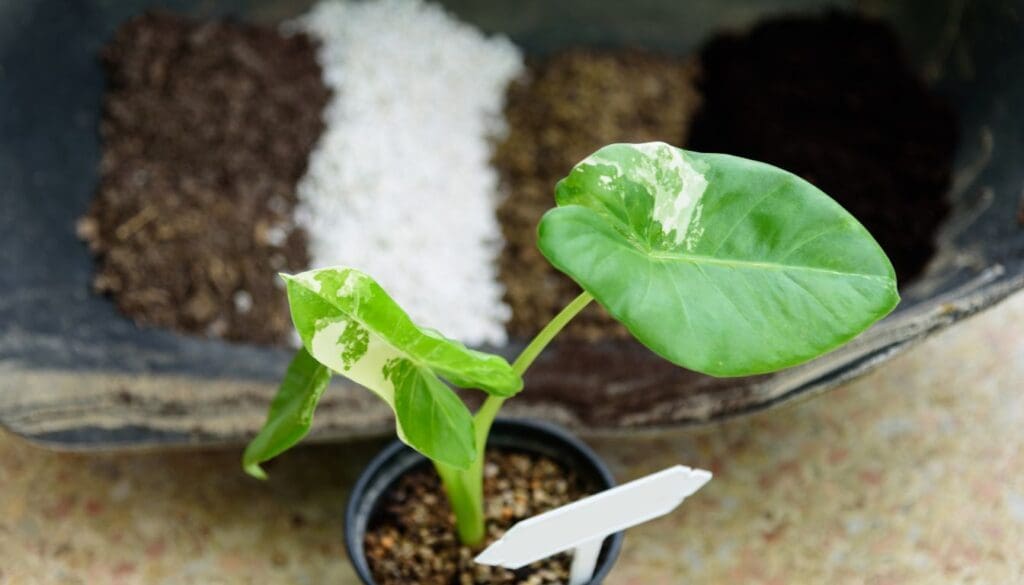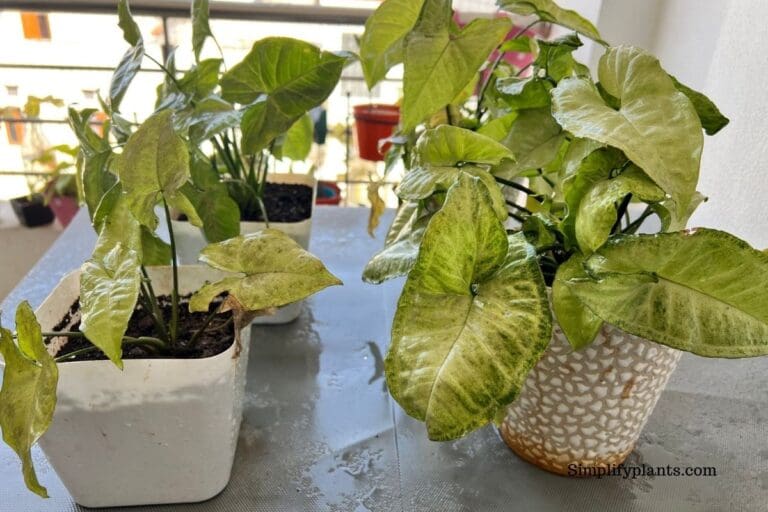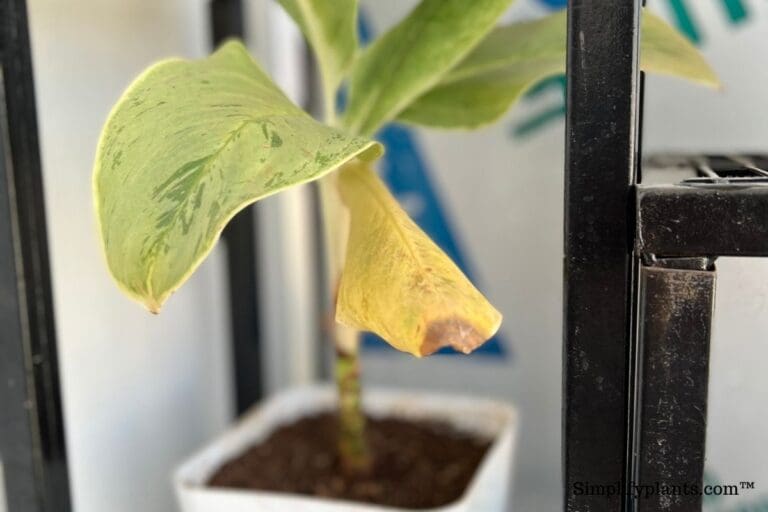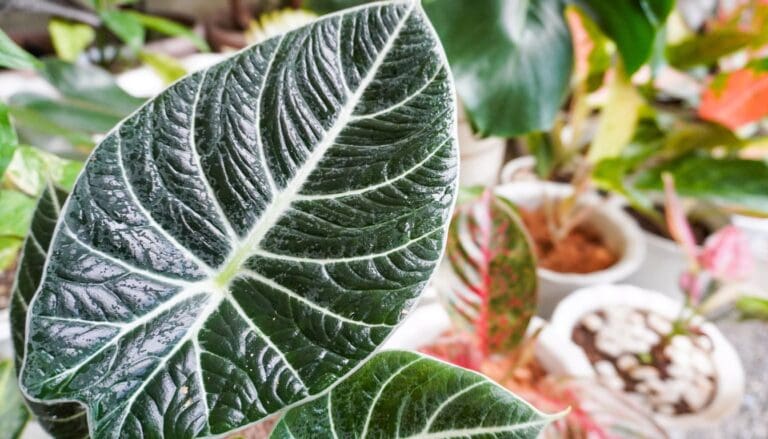Ideal Soil Mix For Alocasia? (Potting Mix Recipe+How To)
Have you ever wondered what soil type is best for your Alocasia plant and how to make the perfect soil mix?
In this blog, we will explore the kind of soil that Alocasia needs and share an ideal soil mix recipe.
Alocasia will thrive in a loose and well-drained potting mix. Avoid using clay-based soil as it remains soggy for long durations. A mixture of regular potting mix, perlite, and peat moss will be ideal for your alocasia. The soil must be slightly acidic with a pH of 5.5 to 6.5.
Let’s find the perfect soil mix for Alocasia plants and learn how to create the best growing environment for them!

Please note: Simplify Plants is reader-supported. Some links in the post are affiliate links and I get a commission from purchases made through links in the post.
Why is it important to choose the right soil for Alocasia?
Alocasia is extremely sensitive to overwatering and can’t stand waterlogged or soggy soil.
Therefore, choosing the correct soil for Alocasia is crucial so it doesn’t experience sogginess.
Since Alocasia is sensitive to overwatering, you should select or prepare a well-drained soil mix that can quickly drain excess water.
However, it doesn’t indicate that the soil should not retain any water.
You must ensure that the soil retains the required moisture that keeps your Alocasia from becoming thirsty too often.
Another important factor that you must not forget is choosing the soil that contains all the nutrients your Alocasia will need for being healthy and growing fast.
The last thing is that the soil should support proper air circulation around the roots to prevent fungal infections.
Your Alocasia will thrive if you consider all these factors while selecting the soil.
Therefore, select a well-drained and nutrient-rich soil that allows proper airflow and retains the required moisture.
What type of soil is best for Alocasia?

Before choosing the right soil mix for Alocasia, let’s find out the factors we need to consider.
Let’s discuss these factors in detail.
Proper drainage
The first thing we need to consider is the soil’s drainage.
I mentioned that Alocasia would not tolerate soggy soil, which tells you the importance of choosing well-drained soil.
If you use regular garden soil, it will be too heavy for your Alocasia as it will retain excess water, which might give rise to fungal diseases and pest infestation.
It can even cause the deadly root rot disease.
Therefore, you should not choose soil with high clay content as it will be heavy and unsuitable for the plant.
If you think the soil has more clay, add some sandy soil or brick powder to improve the texture.
If you want to use well-drained soil, you can add components like:
Proper water retention
Although Alocasia will not enjoy waterlogged soil, it will not prefer being thirsty for too long, either.
Soil that drains too fast without retaining enough moisture will not be suitable for the plant.
This is why balancing drainage and retention is important to get the ideal soil mix for your Alocasia.
If the soil doesn’t hold the required moisture, the plant will dehydrate and not grow or remain healthy.
If you want to improve the retention capacity of the soil, you can add elements like compost and manure.
Mulching is a great way of improving the water retention of the soil.
Mulching doesn’t allow the water to escape the soil by reducing evaporation.
Add wood chips or shredded bark if you want to mulch the soil surface.
Nutrient-rich soil
The soil you select for your Alocasia should be nutrient-rich as the plant will draw its nutrients from the soil.
Therefore, you must always use soil with enough nutrients for your Alocasia.
The nutrients will wash away eventually with each watering.
So, you will need to fertilize the plant to provide sufficient nutrients.
To fertilize your Alocasia, you can use a balanced fertilizer(20:20:20) with a balanced amount of Nitrogen, Phosphorus, and Potassium.
Proper air circulation
Proper air circulation is essential for the roots to stay healthy.
Using the wrong soil mix that becomes compact will not allow proper airflow into the roots.
This will restrict oxygen flow into the soil and suffocate the roots, resulting in root rot or other diseases.
If you want to improve the air circulation of the soil, you can add:
These will make the soil loose and improve air circulation.
Maintain the correct pH level
Alocasia prefers slightly acidic soil with a pH of 5.5 to 6.5.
When getting the soil for your Alocasia, ensure the pH level is ideal for the plant.
Various issues will develop if the pH doesn’t match the plant’s preference.
You will notice stunted growth and foliage problems.
So, check the pH of the soil by using a pH measuring kit, and if the value is lower, you can add limestone powder to increase it.
If the value is higher, you can use peat moss or manure to reduce it.
What is the best soil for Alocasia?

Now that you know the factors behind selecting the right soil mix for your Alocasia, it is time to get hold of some recipes to prepare the ideal one.
You can select any of the following recipes to get the ideal soil mix for your Alocasia.
Recipe 1
With this recipe, you can prepare porous, well-drained soil and retain your Alocasia’s required moisture.
Ingredients:
Uses:
- Potting soil covers everything, including drainage, retention, and aeration.
- Peat moss will improve moisture retention.
- Perlite will regulate retention and aeration.
- Sand will improve the drainage of the soil.
Recipe 2
Ingredients:
- 1 part orchid bark
- 1 part coco coir
- 1 part perlite
Uses:
- Orchid bark holds moisture and releases it slowly so the plant doesn’t get thirsty too fast.
- Coco coir is a cheaper alternative to peat moss, and it improves the moisture retention capacity of the soil.
- Perlite improves aeration and retention capacity.
Recipe 3
Ingredients:
- 1 part potting soil
- 1 part vermiculite
- 1 part sand
- 1 part fir bark
- You can also add a handful of charcoal to it.
Uses:
- Potting soil takes care of retention, aeration, and drainage. It also contains nutrients that the plant needs.
- Vermiculite retains more water than perlite.
- Coarse sand improves drainage and maintains weight as well.
- Bark releases moisture slowly into the soil.
- Charcoal holds onto the nutrients that the plant needs.
You can keep your Alocasia happy with these soil recipes as they will fulfill all the requirements and keep the plant healthy.
Can you use succulent soil for Alocasia?
You can use succulent soil or a cactus mix for your Alocasia.
However, you can’t use it alone as succulent soil will not hold as much water as your Alocasia needs.
The nutrient content of succulent soil will also not match your Alocasia’s requirements.
Therefore, you can mix succulent soil with a potting mix and use it for your Alocasia.
Where should I put my Alocasia?
You should put your Alocasia in a pot with drainage holes.
Alocasia doesn’t enjoy soggy soil and can easily develop fungal diseases like root rot.
A pot without drainage holes will not allow the excess water to drain out, thus, making the soil soggy.
You must also select a pot that is neither too big nor too small for your Alocasia.
Putting your Alocasia in the correct-sized pot is essential for its health.
How do you know your Alocasia needs repotting?

Your Alocasia will need repotting every 2-3 years as it grows fast and will need space for more growth within a few years.
But that knowledge is not enough to know if your Alocasia needs repotting.
You must also understand the plant’s signs to inform you that it needs repotting.
Some common signs are:
- Discolored and pale leaves
- Slow or stunted growth
- Dehydrated plant
- Roots will show on top of the soil.
- Roots will come out of the drainage holes.
- Roots will start displacing the soil.
- If you take the plant out of the pot, you will notice that the roots grow in a circular motion.
If you notice any of these signs, you must consider repotting your Alocasia.
The ideal time for repotting an Alocasia is the spring or summer seasons during its active season.
Avoid repotting in the winter as the unfavorable conditions will not encourage growth and stress the plant more.
How to repot your Alocasia?

Now that you know when you should repot your Alocasia, I will give you a brief idea of how you can do it.
1. Inspect the plant and eliminate the damaged parts
First, you must inspect the plant thoroughly.
Take a sharp and sterilized pruner and remove the plant’s dead, damaged, and unwanted foliage and stems.
Make sure you don’t hurt the healthy ones in the process.
2. Get a new pot and prepare the fresh potting soil
If you are repotting a root-bound Alocasia, you need to get a pot that is one size bigger than the previous one.
A pot that is 1-2 inches bigger will be perfect.
Make sure the pot has drainage holes, as we discussed earlier.
Prepare the soil mix using any of the recipes I mentioned above.
3. Take out the Alocasia from its current pot
Next, you need to take your Alocasia out of its pot.
You can water the plant the day before you want to repot it.
This will allow the plant to come out of the pot more easily.
Since the soil becomes compact, not watering will make it difficult for the plant to come out of the pot.
Hold the stems of the plant and gently pull it out.
You can also turn the pot upside down, making it easier for the plant to slide out.
Tap the sides of the pot to loosen the soil, or run a knife along the sides of the soil if the plant refuses to come out easily.
4. Loosen the roots
Since the roots might be tangled, you must loosen them up before repotting the plant.
You can gently pull the roots to untie them or use a knife if they are too tangled.
You must be very careful while doing these as you don’t want to damage the healthy roots.
If you are repotting an Alocasia with root rot, you must prune the decaying roots, spray fungicide, and put the plant back in a new pot with fresh potting mix.
5. Repot the Alocasia
Take the new pot and add some soil to it.
Now hold the plant, place it at the center of the pot, and add soil from all sides.
Tap the sides of the pot to let the soil settle down.
6. Aftercare
After repotting, water the plant to reduce the stress and help the plant adjust to the new environment.
- Before watering the next time, ensure the soil is 25-50% dry.
- Place the plant in a bright spot with indirect sunlight.
- Fertilize the Alocasia with a balanced fertilizer during the growing months.

Reference: Alocasia sanderiana, Alocasia micholitziana.
Recommended Garden Supplies
| Product Image | Our Recommended Gardening Supplies | Check Offers! |
|---|---|---|
Top Top
Top
Top
Top
Top
Top
Top
Top | rePotme Houseplant and Tropical Classic Potting Soil Mix | Check Offer On Amazon |
 Top
Top
Top
Top
Top
Top
Top
Top | Espoma Organic Indoor Plant Food | Check Offer On Amazon |
 Top
Top
Top
Top
Top
Top
Top
Top | GooingTop LED Grow Light 6000K Full Spectrum Clip Plant Growing Lamp | Check Offer On Amazon |
 Top
Top
Top
Top
Top
Top
Top
Top | Soil Moisture Meter | Check Offer On Amazon |
 Top
Top
Top
Top
Top
Top
Top
Top | Govee Hygrometer Thermometer, Bluetooth Enabled! | Check Offer On Amazon |
 Top
Top | LEVOIT Humidifiers for Large Room(Best For Plants) | Check Offer On Amazon |
 Top
Top
Top
Top
Top
Top
Top
Top | Upgraded DIY Automatic Drip Irrigation Kit, 15 Potted Houseplants Support | Check Offer On Amazon |
 Top
Top
Top
Top
Top
Top
Top
Top | Stainless Steel Heavy Duty Gardening Tool Set | Check Offer On Amazon |
 Top
Top
Top
Top
Top
Top
Top
Top | Bonide Insecticidal Soap | Check Offer On Amazon |
 Top
Top
Top
Top
Top
Top
Top
Top | Bonide 32 oz Spray Neem Oil for Organic Gardening | Check Offer On Amazon |
 Top
Top
Top
Top
Top
Top
Top
Top | Garden Safe Fungicide | Check Offer On Amazon |






